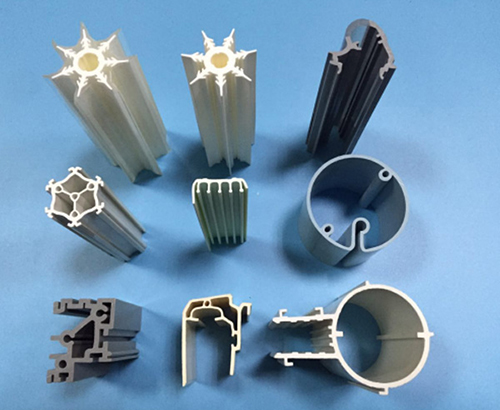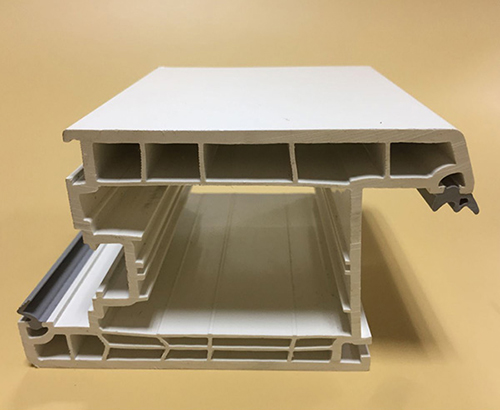Plastic extruder supplier to introduce: plastic by the hopper into the extruder barrel, with the screw screw rotation is forced to the direction of the head. Due to the resistance of the filter screen, the diverter plate and the head mold at the mechanism, coupled with the gradual reduction of the volume between the threads, the forward material is under great pressure, and at the same time it is heated by the cylinder heat source; In addition, plastic in the movement of compression, shear, stirring and other forces, and the cylinder, screw friction and friction between plastic molecules, will produce a lot of heat.Therefore, as the temperature of the plastic in the cylinder keeps rising, its physical state gradually changes from glass state to high elastic state, and finally becomes viscous state, reaching complete plasticization. As the screw has been in the stable rotation, the plasticized material from the head of the die, equal pressure, equal amount of extrusion, into a certain form of plastic products. After cooling finalize the design, complete extrusion molding work, this is the plastic extrusion profile. The core component to realize the above process is the screw rod. The extrusion process occurring on the screw rod includes the following stages.

Plastic Extrusion Profile
First: feed
After the plastic is added to the hopper, it enters the space of the screw groove by itself or under the action of the forced feeder, and extruded forward under the push of the screw edge.However, if the friction coefficient between the material and the metal hopper is too large, or the internal friction coefficient between the material is too large, or the cone Angle of the hopper is too small, the bridging and hollow tube phenomenon will gradually form in the hopper, the material will not smoothly into the screw groove, extrusion will be forced to stop or extremely unstable.Therefore, if the extrusion productivity is abnormally reduced or no material is discharged, it is necessary to check the feeding condition and even change the hopper design.
Second: conveying
In theory, after the plastic enters the screw groove, every turn of the screw, all the plastic will be transported forward one lead, at which time we call the transfer rate 1.However, for each screw, the forward throughput actually depends on the friction factor fb of plastic against the barrel and fs of plastic against the screw. The larger fb or the smaller fs, the more solid plastic will be transported forward.A large number of experiments show that the friction factor of resin to metal mainly depends on the temperature of the system, the surface roughness of the metal or the structure and shape of the system.
Third: compression
It is absolutely necessary that the plastic be compressed during extrusion.First, plastic is a poor conductor of heat. If there is a gap between the particles, it will directly affect the heat transfer and thus the melting rate.Secondly, only under the pressure of increasing along the length of the screw, will the gas between the particles be discharged from the hopper, otherwise, the product will become defective or waste products because of its internal bubbles;Finally, the higher system pressure also ensures the compactness of the product.
There are three reasons for the pressure on the screw:
1. In the structure, the screw groove depth gradually becomes shallow, and the material is gradually compressed;
2. It is installed in front of the screw head with the shunt plate, filter screen, head and other resistance elements;
3. It is the pressure built up along the length of the screw caused by the friction of the material against the metal.The smaller the section area of the nose die, the larger the pressure peak will be, and the highest pressure will move toward the nose. Generally speaking, the pressure peak is in the front of the metering section or the rear of the compression section.
Fourth: melting
In pressure at the same time, the movement of the solid plastic and heating of the machine are compared.in constantly contact and friction, close to the machine are compared.in the plastic material temperature, arriving at melting point on the barrel wall form a thin melt film, as the molten, when the thickness of melt film is greater than the screw and barrel of clearance, the movement of the screw arris will melt film blowing down, formation of molten pool in front of the screw propulsion of the edges.During the melting process, the pool widens and the remaining solids narrow until they disappear completely. This is Tadmor's famous and epoch-making theory of melting published in 1967.
No.5: mixing
During extrusion, under high pressure, solid materials are generally compacted into dense solid plugs. Since there is no relative motion between particles in the solid plugs, mixing can only take place between layers of melt with relative motion.
Sixth: exhaust
In the process of extrusion, there are three kinds of gas to be discharged, one is the air mixed between the powder particles, as long as the screw speed is not too high, generally speaking, this part of the gas can be discharged from the hopper under increasing pressure.But when the speed is too high, the material moving forward too fast, the gas may not be able to exhaust all, thus forming bubbles in the product.The second kind of gas is the water that the material absorbs from the air and turns into water vapor when heated.
For those hygroscopicity of plastic such as PVC, PS, PE, PP, generally what will not happen, these small amounts of water vapor can also be discharged from the hopper;But for some engineering plastics such as PA, PSF, ABS, PC, etc., because of their moisture content is too big, too much water vapor, so too late from the eduction in hopper, which was formed in the course of products of bubbles, the third one is some material inside the plastic particles, such as low molecular volatiles, low melting point plasticizer, etc., they are in the process of extrusion under the action of the heat generated by the gasification step by step, only after the plastic melt, these gases to overcome the surface tension of the melt and escape, but at the moment, because is far away from the hopper, thus cannot tPVC plastic extruded profiles are PVC resin by adding a variety of functional additives, after high temperature extrusion molding PVC products for industry and life.According to the performance can be divided into hard and soft two kinds.Rigid PVC profiles are used in construction, such as production of PVC doors and Windows, PVC floor, PVC pipe;Soft PVC profiles are used for PVC hoses, power cables, etc.

PVC Plastic Extrusion Profile
PVC plastic extrusion profile with added functional additives have anti-aging, anti-uv, anti-corrosion, high strength, cheap price, good heat preservation and insulation performance, can partially replace aluminum profiles, steel, pollution is lower than aluminum profiles.hrough the hopper. In this case, the exhaust extruder has to be used.